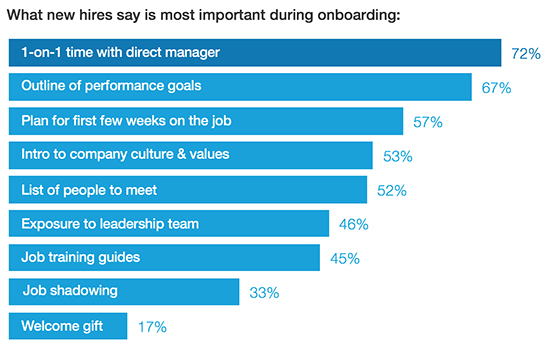
A guide for navigating onboarding and making sure new hires get off to a great start.
Ah yes, that candidate you’ve been after has finally signed your offer letter. Time to watch them cruise on in and be successful.
Sadly though, that’s not how things work. Data shows that onboarding a new hire can make or break how they perceive the company and how productive they are. So if you want that new hire to stick around and kick butt, you need to make sure your onboarding process goes above and beyond.
To help you understand what you need to do to succeed, LinkedIn surveyed 14,000 global professionals about the types of onboarding techniques they preferred most in our newest study, Inside the Mind of Today’s Candidate,
The results were revealing—and somewhat unexpected. For example, despite the widespread popularity of bestowing swag on new hires, only 17% of all survey respondents named welcome gifts as “very useful” to their onboarding process. Respondents also didn’t insist on job shadowing (33%) or getting a welcoming shout-out at a staff meeting or department lunch (17%).
Most surprisingly, respondents of all ages, nationalities, and genders named the five exact same onboarding practices as most useful:

Employees in every surveyed country overwhelmingly agreed that the best way to get ramped up and ready for work is to spend one-to-one time with their direct manager. A whopping 96% of respondents found these meetings to be at least somewhat useful, while 72% found them to be very useful.
Specific preferences varied by seniority. While all seniority levels preferred this onboarding technique, VP-level employees found it overwhelmingly valuable, with 80% rating the meetings as extremely useful. It could be that VPs, the lieutenants of your company, benefit most from leadership direction from the executives they report to.
Make sure that your hiring managers schedule one-on-one time with their new reports. This gives new employees time and space to hear about their responsibilities—and lay a solid foundation for their most crucial work relationship.
Clocking in as “useful and ideal” for 67% of all survey takers, employees made it known they wanted a clear outline of upcoming expectations. Outside of knowing what to do, respondents cast their vote for learning how to do it well, long-term.
The Chicago Tribune found that a lack of career development is one of the top reasons people leave jobs. To climb ladders, it makes sense to let new hires in on where the rungs are, how many there are, and how far apart. Female professionals ranked this onboarding information particularly high, with 73% of women choosing it, versus 65% of men.
When employees know what’s expected of them in the long run—and how to succeed—they will be more likely to go above and beyond. Laying a clear outline of requirements and goals helps set the tone for success.
Starting a new job is daunting. Unlike the first day of school, when everyone is new, your new hire is the sole novice among peers whose responsibilities are old hat. Setting up a schedule for the first few weeks can help ground new employees until they’re able to get into a routine of their own.
The study found this especially true among lower-level employees. 59% of junior-level employees liked the idea of a starter agenda, versus 53% in the C-suite. Younger and greener, these new hires need more direction at the get-go.
In line with the seniority breakdown, millennials were also more likely to prioritize an agenda for the first week. Companies that offer a concrete agenda convey that they prepared for the employee’s arrival and are excited for them to join the team. Without any direction, new hires—especially in the younger generation—may feel neglected.
Welcoming new employees with a clear schedule is a must: it’ll provide reassuring structure while they get their bearings and settle in.
More and more, we’ve seen companies place a premium on culture as a selling pointfor joining a team. But attracting candidates with your culture isn’t enough. Many employees prefer a formal introduction.
53% of global professionals surveyed said that receiving explicit background on their new company’s culture and values, whether through an employee manual or a chat with the boss, is very useful. Surprisingly, baby boomers were most likely to prioritize this cultural introduction, compared to other age groups.
It’s important to follow-up on the culture you’ve sold candidates on—and formalize it into your onboarding process.
New hires spend most of their time learning their responsibilities, but they also need to get to know their new teammates, too. To help with this, 52% of survey respondents prefer receiving a list of co-workers they should meet (or having a meeting set up on their behalf).
Respondents from the U.S. (60%) and France (61%) are most likely to ask for this onboarding tactic, compared to just 39% in Japan. Women were also more likely than men to prefer this onboarding activity, at 59% versus 49%.
There are plenty of ways to make a new hire feel comfortable and welcomed, but you can’t go wrong listening to what employees themselves say is most useful. To learn more about what professionals think of onboarding and other recruiting topics, download the report.
And don’t forget, the Invoke team is always here to help you with your hiring process. In need of your next great hire? Get in touch with us today.
Invoke Staffing provides equal employment opportunities (EEO) to all employees and applicants for employment without regard to race, color, religion, sex, national origin, age, disability or genetics.